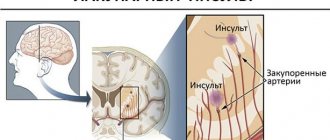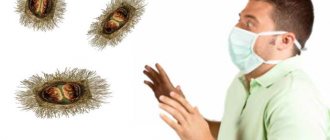PROGRESSIVE PARALYSIS
(
paralysis progressiva
, synonym:
progressive paralysis of the insane, paralytic dementia, Bayle's disease
) is a late form of neurosyphilis, characterized by impaired mental activity - progressive total dementia.
One of the first cases of undoubted P. p. was described by J. Esquirol. In 1822, A. Bayle identified P. p. as an independent disease, emphasizing that it causes both mental disorders and neurol, disorders associated with hron. inflammation of the arachnoid membrane of the brain. Bayle's statement has met with objections from some researchers. And only in the 50s. 19th century progressive paralysis was recognized as an independent disease.
P. p. suffers approx. 5% of all patients with syphilis (see), and women get sick much less often than men. The disease usually occurs 10-15 years or more after infection. Thus, if we take into account that the period of greatest sexual activity falls by 20-35 years, the age of those affected is most often 35-50 years. When infected with syphilis at a late age (45-60 years), this period is usually shortened.
Clinical picture
P. p. is a serious disease of the whole organism, and its most striking manifestations are disturbances in mental activity. The main syndrome is progressive total dementia (see): the intellect suffers severely, disorders of judgment appear early, criticism and especially self-criticism disappear. There is no awareness of the disease, memory sharply decreases, and confabulations occur (see Confabulosis). Manifestations of dementia intensify due to the often observed euphoria (see Psychoorganic syndrome). Neurol. the symptoms consist of speech disorders, primarily in violation of articulation - dysarthria (see). Speech becomes unclear, slurred, especially when pronouncing long words, the patient skips or rearranges syllables, and does not pronounce the endings of words. Handwriting becomes uneven, individual letters and syllables drop out of words. The timbre of the voice changes, it becomes dull. The patient's face is expressionless and mask-like, because the innervation of the facial muscles is disrupted, and blepharoptosis occurs (see Ptosis). Tendon reflexes are often increased and uneven, except in cases of taboparalysis (see). Due to sphincter disorders, patients cannot retain urine and feces. As a result of vasomotor and trophic disorders, swelling, brittle bones, muscle atrophy, and bedsores appear.
Based on psychopathol. manifestations, four stages of the disease are distinguished: latent (from infection with syphilis to manifestations of P. p.), the stage of initial manifestations, the stage of full development of the disease and the stage of marasmus (see). In the latent stage, headaches, dizziness, fainting may occur, and in some cases characteristic changes in the cerebrospinal fluid are observed (see). The stage of initial manifestations is characterized by increased fatigue, irritability, and weakness. Patients complain of loss of strength and decreased performance, although they can still perform their usual work to some extent. Previously, such conditions, due to their external resemblance to neurotic symptoms, were incorrectly called preparalytic neurasthenia. In some cases, at the stage of initial manifestations, depressive and delusional disorders are observed - anxious depression with hypochondriacal statements, anxious-agitated depression, delusional ideas of jealousy, persecution, poisoning; as the symptoms of dementia increase, these endoform disorders disappear. Memory loss is detected very early. Certain actions indicate a violation of criticism. The sphere of desires is upset, patients become gluttonous and erotic. The increase in these disorders indicates the transition of the disease to the stage of full development, the edges manifest themselves in different wedges. forms. The expansive, or classic, form (previously widespread) is more common in men. It is characterized by the presence of manic excitement with the manifestation of anger, grandiose delusions of grandeur (see Delirium). The dementia form is characterized by increasing dementia against the background of inactive euphoria. In the depressive form, a depressed mood develops, often with anxiety and a desire for suicide (see Depressive syndromes), and absurd hypochondriacal delusions of nihilistic content are often observed. The circular form, first described by S.S. Korsakov, occurs with alternating states of excitement and depression. The hallucinatory-paranoid form is characterized by the development of paranoid syndrome (see) with predominantly auditory hallucinations and delusions of persecution. In the catatonic form, a stuporous state occurs (see) with phenomena of mutism and negativism (see Catatonic syndrome). In the stage of insanity, conscious activity ceases, speech disappears, patients make inarticulate sounds, and cannot stand or move. At this stage they die from an intercurrent disease.
Along the way, a particularly malignant agitated form is distinguished (galloping paralysis) with sharp motor excitation and disturbance of consciousness of the amentive type and the so-called. stationary paralysis, in which there is a slow course with a gradual decrease in intelligence and lethargy.
Atypical forms of P. p. are youthful and senile P. p., as well as Lissauer’s palsy and taboparalysis (see). Juvenile P. p. develops on the basis of congenital syphilis; usually begins at the age of 10-15 years. Sometimes it is preceded by signs of congenital syphilis, in other cases it occurs in children who were previously considered healthy. Most often occurs in the form of dementia; Local symptoms are often observed, for example, optic nerve atrophy. Senile P. p. occurs over the age of 60 years and is characterized, first of all, by a long latent stage (up to 40 years). Wedge, the picture resembles senile dementia (see) with severe memory disorders; sometimes the disease occurs like Korsakov's syndrome (see).
Lissauer's palsy and taboparalysis are characterized by a relatively slow progression of dementia. With Lissauer's palsy, there is a tendency to local damage to the brain, mainly the parietal lobes, with the development of aphasia (see), agnosia (see), apraxia (see), apoplectiform and epileptiform seizures. Taboparalysis is a combination of symptoms of P. p. and tabes dorsalis (see), and spinal disorders precede the development of symptoms of P. p., usually its demented form.
Ways of transmission of syphilis
The main way of contracting syphilis is through sexual intercourse. You can get infected through vaginal, anal and oral sex.
It is also possible to transmit syphilis through a needle (when using the same syringe with a syphilitic) or through a blood transfusion (if a healthy person receives a blood transfusion from a sick donor). This type of syphilis infection is extremely rare, as donated blood is now carefully tested before transfusion.
It is important to remember that anyone who is sexually active can get sick. Those at risk for syphilis are:
- patients with HIV infection and AIDS;
- sex workers and their clients;
- people who have unprotected sex;
- drug addicts;
- people undergoing pre-infection prophylaxis (daily intake of special medications by HIV-positive patients. Such prophylaxis prevents HIV from spreading in the body and minimizes the risk of infection through sexual intercourse or a syringe, but does not protect against sexually transmitted diseases, including syphilis).
Congenital neurosyphilis Newborns can become infected with syphilis from their mother. The bacterium enters the fetal blood through the placenta. The risk of infection of the child is high if pregnancy occurs in the third year after the woman becomes infected with the infection. Congenital syphilis is characterized by skin rashes (red blisters and rashes), cracks around the mouth, and nosebleeds. Possible convulsions and fits, deafness. Children over two years of age experience vision problems and ulcers around the mouth and nose. The spinal cord is affected, teeth and bones grow poorly. If the infected mother seeks treatment in time, taking medication (penicillin) will also cure the fetus. If treatment is started late (less than 4 weeks before birth), the possibility of infection of the fetus increases.
Etiology and pathogenesis
In 1913, H. Noguchi proved the syphilitic etiology of P. p. by discovering treponema pallidum in brain tissue.
Pathogenesis has not been studied enough. K. Levaditi, based on observations when both spouses or several persons infected with syphilis from the same source fell ill with syphilis, suggested the existence of a special neurotropic treponema. which, however, has not been proven. Perhaps disturbances in the reactivity of the body (see) with sensitization of brain tissue play a role in pathogenesis, as a result of which in some cases treponemes penetrate into the brain tissue.
What is neurosyphilis?
Syphilis is a sexually transmitted infectious disease caused by the bacterium Treponema pallidum (treponema pallidum). Syphilis infection usually occurs through the mucous membranes of the genitals or mouth, but subsequently the disease can affect almost all body systems. Neurosyphilis occurs when the infection affects the brain and spinal cord. How often do people get syphilis?
It is a mistake to think that syphilis is a thing of the past. In 2012, the World Health Organization (WHO) reported 5.6 million syphilis infections in men and women aged 15 to 49 years. However, quite often the infection is not treated properly and leads to serious complications.
The American Medical Association examined 233 patients with syphilis. Neurosyphilis was diagnosed in 21% of these patients (50 people).
In Russia, from 2010 to 2014, the increase in the number of cases of neurosyphilis was 73%.
Pathological anatomy
Macroscopically, with P. p., atrophy of the brain convolutions and widening of the furrows are noted. The soft membrane of the brain is clouded, fused with the substance of the brain; ependymatitis is observed (see Chorioependimitis). Microscopically, an inflammatory process is detected in the pia mater of the brain and in the vessels, especially small ones. Infiltration with plasma cells is characteristic near the vessels. In the brain tissue, desolation of the cortex is observed due to the destruction of nerve cells and fibers. Gliotic fibers grow in neuroglia, and rod-shaped and amoeboid cells appear. Treponema pallidum is found near nerve cells.
Diagnosis
Diagnosis
in the stage of full development of the disease usually does not cause difficulties. It is established on the basis of psychopathological, neurological manifestations and laboratory data. research. Increasing phenomena of total dementia with a lack of criticism, dysarthria, impaired pupillary reactions (see Argyll Robertson syndrome), persistence of serols. indicators - all this together makes the diagnosis of P. p. reliable. The Wasserman reaction in the blood is in most cases positive (see Wasserman reaction); in the cerebrospinal fluid, it, like the protein reactions (Nonne-Apelt, Pandi, Weichbrodt), is sharply positive (see Coagulation tests, Cerebrospinal fluid). The number of cellular elements in the cerebrospinal fluid is increased, sometimes significantly. The total protein content is increased. When performing the Lange reaction (see Cerebrospinal fluid), there is a discoloration of the liquid in the first 4-6 tubes and an increase in color intensity in the next (the so-called paralytic curve). The treponema immobilization reaction (see Nelson-Meyer reaction) and the immunofluorescence reaction (see) are sharply positive in the blood and cerebrospinal fluid.
Differential diagnosis
carried out with syphilis of the brain (see Syphilis), in which dementia is lacunar in nature with greater or lesser preservation of criticism, hallucinations are more often observed; The Lange reaction curve has the so-called syphilitic tooth. P. p. are differentiated from alcoholic pseudoparalysis (see Alcoholic encephalopathies) and senile dementia (see) on the basis of serol. indicators; with brain injuries (see), especially the frontal lobe, according to neurol, symptoms and serol. indicators. Pseudoparalytic syndrome in brain tumors is accompanied by increased intracranial pressure (see Hypertensive syndrome). Psychoses of vascular origin differ from P. p. by the development of lacunar dementia (see Atherosclerosis), which is not characteristic of P. p. The presence of paralytic dementia makes it possible to distinguish the circular form of P. p. from manic-depressive psychosis (see), and the hallucinatory-paranoid form - from schizophrenia (see).
Symptoms of pathology
Symptoms of progressive paralysis will manifest themselves as follows:
- speech impairment and failure in the ability to connect complex words;
- a patient diagnosed with progressive paralysis loses the ability to do basic math, and his motivation decreases significantly;
- the patient's consciousness is clouded;
- memory is lost - both short-term and long-term;
- muscle atrophy and weakness are observed in the upper and lower extremities, as well as weakness in other parts of the body;
- attacks of delirium and hallucinations, increased attacks of irritability and irascibility, which are followed by attacks of depression and moodiness;
- muscle cramp.
Treatment
Pyrotherapy is indicated (see) - inf. therapy and pyrogenic substances (see) in combination, as a rule, with antibiotic therapy. Back in 1845, V.F. Sabler noted the beneficial effect of a number of febrile diseases on the course of psychoses. Priority in inf. therapy of psychosis belongs to A. S. Rosenblum, who treated mentally ill patients with relapsing fever vaccination. In 1917, the Viennese psychiatrist J. Wagner-Jauregg proposed treating patients with P. p. with malaria vaccinations. The method has become widespread; it consists of injecting subcutaneously into a patient P. a p. of blood taken from a patient with three-day malaria. The incubation period lasts 4-20 days, the first attacks are similar to three-day malaria, and then, as a rule, are observed daily. After 10-12 attacks, they are stopped by taking quinine hydrochloride. Inf. therapy is also carried out by infecting patients with P. p. with European and African relapsing fever. The results of this therapy are less pronounced, but it is convenient, because the grafting material, previously obtained as a result of infection of the mouse, can be transported over long distances. Somatically weakened patients are vaccinated with Japanese rat typhus - sodoku. In cases where infection fails, as well as in case of somatic contraindications, pyrogenic substances (pyrogenal, etc.) are prescribed.
Since the 40s 20th century carry out complex treatment - pyrotherapy in combination with the administration of antibiotics. In this case, 40,000,000 units of penicillin are prescribed for the course of treatment; Repeated courses of penicillin therapy are carried out at intervals of up to 2 months. iodine control serol. indicators. In some cases, bicillin is used in combination with bismuth preparations. In combination with antibiotic therapy, inf. therapy (malaria vaccination), which promotes the penetration of antibiotics into brain tissue, and in addition, increases the body's defenses. Inf. Therapy is contraindicated in old age, with marasmus, heart failure, aortic aneurysm, kidney disease, and diabetes. In addition, a treatment with penicillin alone has been developed. Several treatment regimens with penicillin have been proposed, but some researchers consider the use of penicillin alone to be insufficient.
Prevention
Prevention of syphilis comes down to preventing infection. To reduce the risk of infection, you should:
- Have protected sex (condoms do not provide a 100% guarantee against contracting sexually transmitted diseases). If you change partners frequently, undergo examinations at least once a year.
- Be in a monogamous relationship with one trusted partner.
- If you suspect an infection, immediately consult a doctor for examination.
Proper prevention and taking care of your own health will help prevent the disease or cope with its consequences.
Forecast
The duration of the course of untreated P. from its initial manifestations to death is on average approx. 2Y2 years. Youth paralysis progresses more slowly (5-6 years), stationary paralysis - up to 20 years or more. The agitated form ends with the death of the patient after a few months. In the expansive form, long-term remissions are observed. Remissions after treatment vary in duration. Remissions of St. 20 years. According to a number of researchers, remissions for more than 2 years are stable.
Prevention
consists in timely treatment of syphilis, which is carried out with specific and nonspecific means according to certain schemes (see Syphilis).
Consequences, prognosis
Neurosyphilis can be treated with antibiotics, but many of its effects are irreversible.
In severe forms of the disease, signs of successful treatment are usually limited to only partial restoration of body functions.
The exception is mild forms of the disease: asymptomatic neurosyphilis and meningitis neurosyphilis, identified in the early stages. In this case, the cure is complete.
Meningovascular syphilis often causes acute cerebrovascular accident (stroke). The extent and timing of recovery after cerebrovascular accident are individual in each case.
Congenital syphilis is characterized by high mortality. According to WHO, it has become one of the leading causes of death in newborns in 2021. In total, 200,000 deaths were recorded.
Important! Neurosyphilis, like syphilis, does not contribute to the development of immunity from re-infection.
Social and forensic psychiatric significance
Only in isolated cases (persistent remission after treatment) can the patient be allowed to return to his previous professional activity. During a forensic psychiatric examination (see) of the patient, insanity is established in almost all cases (see). Only with treated P. p. with a stable remission lasting at least 3 years can the patient be declared sane.
Bibliography:
Venereal diseases, ed. O. K. Shaposhnikova, p. 174, M., 1980; Gordova T. N. Clinic and course of progressive paralysis treated with malaria, M., 1959, bibliogr.; Gurevich M. O. Pathological features of progressive paralysis in connection with clinical data and treatment of malaria, in the book: Psychiat. hospital on the path to reconstruction, ed. I. N. Koganovich, p. 179, M.-L., 1934; Miniovich P. A. Malarial therapy of neurolesia and other diseases of the nervous system, Rostov n/D., 1934; R o-zenblum A. S. On the relationship of febrile illnesses to psychoses, Works of doctors Odessa. mountains hospitals, in 2, p. 73, Odessa, 1876; Bruetsch WL Neurosyphilitic conditions, Amer. handb. psy-chiat., ed. by S. Arieti, v. 2, p. 1003, NY, 1959, bibliogr.; Gerstmann J. Die Malariabehandlung der progressiven Paralyse, Wien, 1928; Handbuch Geisteskrankheiten, hrsg. v. O. Bumke, Bd 8, T. 4, S. 147, 315, B., 1930, Bibliogr.; W a g-ner-Jauregg J. Fieber- und Infektionstherapie, Wien ua, 1936; Weitbrecht HJ Psychiatrie im Grundriss, S. 216, B. - NY, 1973.
D. S. Ozeretskovsky.
Reasons for the development of neurosyphilis
The main danger of syphilis is that in the early stages of development, which sometimes last for many years, it may practically not manifest itself at all, and after that it completely goes underground - the latent phase. At the same time, all the symptoms disappear, and here lies the main danger of the disease. Sometimes, after many years, undiagnosed or undertreated syphilis makes itself known - tertiary syphilis develops. Tertiary syphilis can affect almost all human organs and systems, including the heart, kidneys, liver, bones, joints, eyes and skin. When the infection affects the central nervous system, neurosyphilis develops. In this case, the patient faces paralysis, memory loss and dementia.











